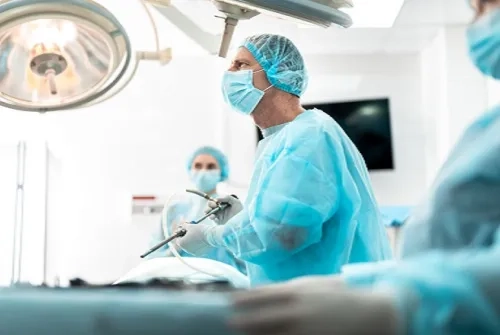Alo Yeditepe
Alo Yeditepe
What is Laparoscopic Surgery in Gynecology?
What is Laparoscopic - Endoscopic Surgery?
Actually, laparoscopic surgery encompasses all endoscopic surgical methods. What is endoscopic surgery? Let me briefly explain this first. It refers to surgeries performed inside the body using thin cameras. For example, the procedure performed in the stomach is called "gastroscopy," entering the bladder is called "cystoscopy," and entering the abdomen is called "laparoscopy." In other words, surgeries performed inside the body with thin cameras in a minimally invasive manner are referred to as endoscopic surgery.
In Women, Which Diseases are Treated with Closed Surgeries?
In today's world, these methods can be used for almost all gynecological diseases. Diseases such as fibroids, cysts, uterus removal surgeries, urinary incontinence operations, and even gynecological cancers can be treated with closed methods. These methods are generally preferred and are effective in the treatment of pathologies within the uterus. With a method called hysteroscopy, problems inside the uterus can be seen by entering through the vagina with a thin camera, and they can be treated in the same session.
What is Hysteroscopy?
The treatment of pathologies inside the uterus with a closed method can be defined as hysteroscopy. However, there is a difference between H-hysteroscopy and laparoscopy. In hysteroscopy, a very thin camera is inserted through the vagina to reach the inside of the uterus. Any pathology such as polyps or fibroids inside the uterus is detected, and the treatment is carried out by removing them in the same session. This procedure is defined as hysteroscopic surgery.
What Was the Procedure Before Minimally Invasive Surgeries?
Before minimally invasive surgeries, up until 30-40 years ago, open surgeries performed through the abdomen were commonly used. However, nowadays, minimally invasive methods are preferred due to advantages such as less bleeding, lower risk of infection, and shorter hospital stays.
Laparoscopic Methods Used for Diagnostic Purposes?
Laparoscopic methods can also be used for diagnostic purposes. Especially in cases of infertility, laparoscopic surgery is frequently preferred. With this method, factors such as the functionality of the fallopian tubes can be examined, and if necessary, treatment can be applied in the same session.
Can Diagnosis and Treatment Be Done Simultaneously?
Yes, with these methods, instant diagnosis and treatment are possible. For example, if an issue is detected in the fallopian tubes, treatment can be applied in the same session. With hysteroscopy, pathologies within the uterus can be identified and removed.
How Is the Decision Made to Perform Laparoscopic Surgery?
The decision to undergo laparoscopic surgery is typically made through mutual consultation with the patient. Laparoscopic methods are preferred due to their advantages such as being more comfortable for the patient and having shorter recovery times. The decision is reached after a detailed discussion with the patient.
How Are Laparoscopic Surgeries Performed?
Laparoscopic surgeries are typically conducted using the navel (belly button) as a natural entry point, leaving no visible scars. Other entry points are usually made in the groin area. The incisions are generally small and, once healed, leave almost no visible marks. Moreover, in some cases, these surgeries can be performed without any incisions. For example, if there is a fibroid or polyp in the uterus, it can be addressed through hysteroscopy by entering through the vagina. The goal is to utilize natural cavities as much as possible, minimizing postoperative pain. Since there is no skin incision in closed procedures, patients experience less pain. After surgery, some discomfort may be felt due to the gas used to inflate the abdomen, but it typically dissipates on its own within 1-2 days.
What Are the Advantages of Laparoscopic Surgeries?
Laparoscopic surgeries, commonly used in women's health today, offer significant comfort to patients due to the advantages they provide. Some of these benefits include:
Surgical Opportunity with Small Incisions:
Laparoscopic surgery provides a less invasive approach compared to traditional open surgery methods. It is performed with small incisions, which can accelerate the healing process and reduce the risk of complications.
Less Bleeding:
Laparoscopic surgeries performed with small incisions are typically characterized by less bleeding. This condition can assist patients in having a more comfortable postoperative period.
Less Pain:
Small incisions and minimal tissue disturbance typically result in less postoperative pain. This enables patients to recover more quickly.
Shorter Hospital Stay:
Laparoscopic surgery generally requires shorter hospital stays. This allows patients to return to their normal daily activities sooner.
Less Risk of Infection:
Small incisions and minimal tissue disturbance can reduce the risk of infection. Additionally, the use of sterile endoscopic equipment during surgery minimizes the risk of infection.
Better Cosmetic Results:
Laparoscopic surgeries typically leave smaller scars, allowing for better cosmetic results.
Faster Recovery:
Laparoscopic surgeries, with their minimally invasive nature, are generally associated with faster recovery times. This allows patients to return to their normal lives more quickly.
Having Fewer Visible Scars:
As a result of small incisions and minimal tissue manipulation, patients may have fewer noticeable scars.
Utilization of Advanced Imaging and Technology:
The equipment used for laparoscopic surgeries includes high-resolution cameras and other advanced technological tools. This allows the surgeon to have better visualization and perform more precise manipulations.
Laparoscopic surgery has become a preferred method in many surgical interventions due to these advantages. However, as in any surgical procedure, it is crucial to make decisions about the method to be used based on the needs of the surgeon and the patient, as each patient's condition is unique
About
Faculty and Year of Graduation:
Hacettepe University Faculty of Medicine, 2009
”
See Also
- Contraceptive Methods: Birth Control and Effective Protection Options
- Uterine Polyps, Symptoms and Treatment
- What is Pelvic Floor? What are Their Duties?
- What is Hysteroscopy? Hysteroscopy Usage Areas
- What is Myoma? Myoma Symptoms and Treatment
- Causes of Female Infertility
- The Use of Non-Inpatient Closed Surgery is Increasing in Gynecological Diseases
- Chronic Pelvic Pain
- What is Polycystic Ovary Syndrome/PCOS?
- Postpartum Period
- Imaging Methods During Pregnancy
- Causes of Male Factor Infertility
- The Effect of Advanced Age on IVF Treatment
- Infertility
- Polycystic Ovary Syndrome
- Early Menopause
- Blocked Fallopian Tube
- Vaginismus
- Low Ovarian Reserve (AMH)
- Which Methods Increase Success in Treatment of Infertility?
- Intrauterine insemination (IUI)
- Microinjection
- Egg Cryopreservation
- Assisted Hatching
- Micro-chip
- Pre-implantation Genetic Diagnosis
- 10 Overlooked Signs of Menopause
- Endometriosis
- Co-Culture
- Ovarian Rejuvenation / PRP
- Getting Cancer Treatment Does Not Stop You from Having Children!
- Considerations for Embryo Transfer
- What Causes Menstrual Irregularity, How Is It Treated?
- Untreated Genital Problems Can Cause Urinary Incontinence
Alo Yeditepe





